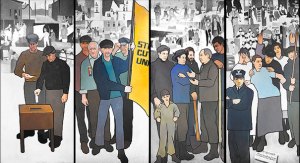The mural at issue in this case (pictured above) was painted by Judy Taylor and depicted a shoemaker teaching an apprectice, child laborers, women textile workers, workers casting secret ballots, the first Labor Day, woods workers, striking workers, labor reformers, women working during World War II, and the future of Maine labor.
Governor LePage sought to have the mural removed after he was sworn into office in 2011, citing complaints that the mural was pro-labor and gave an impression that the Department of Labor was not equally receptive to both businesses and workers. After the mural was removed, he stated that his objection to the mural was not due to its depiction of organized labor, but rather to the source of its funding. As he explained in an interview, “the money was taken out of the unemployment insurance fund which is dedicated to provide benefits to unemployed workers. They robbed that account to build the mural.”
Five residents sued the governor, claiming that the mural’s removal was impermissibly content and viewpoint-based. The First Circuit disagreed, however, explaining that “It is not the mural standing alone which is at issue, but what the mural’s presence in the MDOL waiting room signified. The message the government did not wish to portray, of non-neutrality, came from the particular location of the mural; the government did not have an objection to an alternative location…. The government, without violating the First Amendment, may, in this setting, choose to disassociate itself from an endorsement implicit from the setting for the mural, which it reasonably understood as interfering with the message of neutrality the administration wishes to portray. This is so whether the mural is anti-labor or pro-labor…. Many cases recognize that the government must have some discretion as to the choice of art it puts on the walls of its offices, even where the government is acting as an arts patron. It has discretion to make aesthetic judgments, with which some will agree and others will disagree…. Circuit courts have routinely rejected First Amendment claims brought against government officials who have chosen to remove art works, offensive to some but not others, from the walls of working government institutions on the grounds they were inappropriate to that location. Further, the law clearly gives governments leeway to take into consideration the problem of the captive audience and complaints it has received from those who viewed the art work while visiting government offices for other reasons.”
Sources:
- Newton v. LePage, 2012 U.S. App. LEXIS 24559 (1st Cir. Nov. 28, 2012)
- Jennifer Epstein, Maine governor removes labor mural, Politico, Mar. 28, 2011

No comments:
Post a Comment